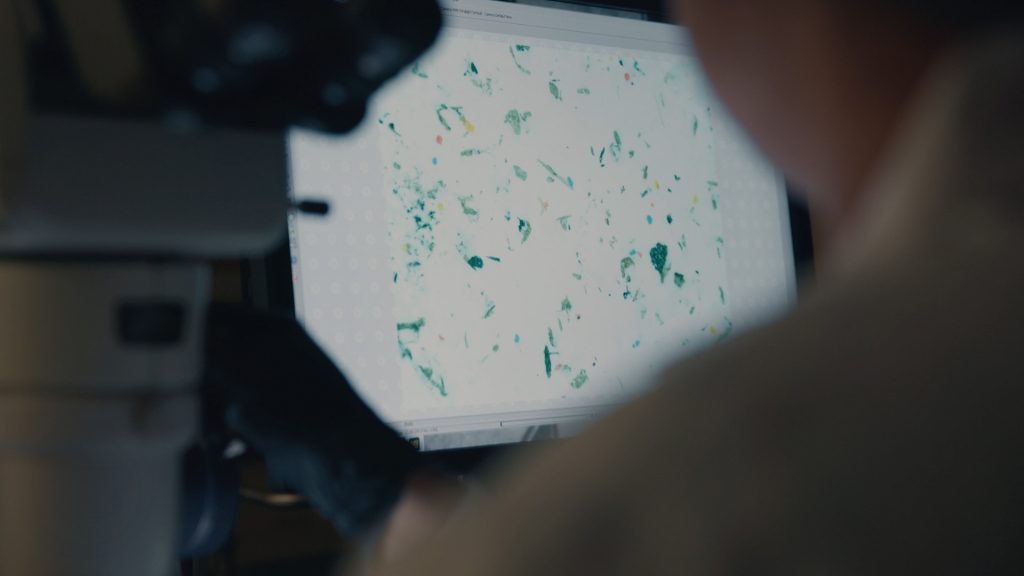Meet Jeanne, sustainability lead, BASF
What Are Microplastics?
And How Are Plastic Makers Addressing Microplastics?
Microplastics are in the news. And in our environment. What do we know about them?
So… what are microplastics?
Jeanne – one of the leaders in the scientific field that researches microplastics – describes them simply:

“Microplastics are typically considered to be solid plastic pieces that are five millimeters or less in size, smaller than the tip of a
pencil eraser. Often much smaller.”
Microplastics are a relatively new phenomenon, but the science is quickly advancing.
“The scientific understanding of microplastics is in its infancy. So, we really need to focus on the fundamentals associated with
understanding them.”
That means figuring out the basics. How to define microplastics. How to identify and measure them in our environment.
Understanding their potential impact on people and our environment. So we can determine how to best respond to this phenomenon.
“We need to better understand microplastics, how they’re generated, where they end up, what’s their impact? This gives us
information to generate solutions, to answer the question, ‘How can we make circular economy products and processes to
avoid the generation of microplastics and leakage into the environment?’”
FYI: Circular economy = reusing plastic or keeping plastic in use as long as possible, rather than discarding it, which helps keep it out
of our environment.
Jeanne’s in a pretty solid place to help.

“I did microplastics research work in my graduate degree at the University of Michigan, focused on understanding interfaces
of plastic and the environment. I ended up working with scientists focused on understanding microplastics in the Great Lakes.
My role was to help with the analytics and method development to identify those materials.”“And I’ve been working on the topic at BASF since 2019. Now I manage our Biodegradation and Microplastics Center of
Excellence.”
Meet Jeanne. One of America’s Change Makers.
What are plastic makers doing to address concerns about microplastics?
Jeanne is part of a growing cadre of scientists and other technical experts focused on microplastics and creating a circular
economy for plastics.

“We’re not doing this alone, so it’s not just me at BASF, of course. Within the company we have many experts working
on this.”“And there is an extensive global network outside of BASF that we work with as well. We have collaborations with other industry
scientists and consortia, for example. We also work with government scientists and with a wide variety of different academics
and universities across the world.”
It’s not easy work. And it’s complicated.
“Microplastics itself is really a tough, nuanced and diverse topic of science. So, it takes a lot of collaboration between industry
and government and academia to address the potential hazards for microplastics and to address the unknowns associated
with them. And to generate solutions as well.”“It really does take a global community to tackle such a complex topic, and this is what we’re doing.”
The initial goal of all this work? Better scientific understanding.
“With academics, as an example, we want to understand the environmental impact of microplastics, to look at the
fragmentation and degradation of microplastics. And for a variety of different topics, we really want to advance the science.”
The ultimate goal? A cleaner environment.
“Our ultimate goal is to avoid microplastics from leaking into the environment in the first place. We look towards the future for
innovation to generate new products and new processes to avoid microplastics leakage.”
Innovation. Jeanne and her colleagues rely on this primary attribute of plastic makers.

“Innovation is absolutely key to keeping microplastics out of the environment. When we design products with final end of
life in mind, or with a circular economy in mind, we need to make sure that we understand where those plastics will end up.
Is it a chemical recycling plant? Mechanical recycling? Is it a compost facility? We want these materials to end up in the
appropriate controlled stream so that we don’t have microplastics leakage into the environment.”
It’s a lot to take on for any scientist. To keep herself grounded, Jeanne indulges her passion for art. Today that means working with clay.

“When I think of plastic, I think of it as one of the most transformational types of chemistries that we have available to us. So
similar to lumps of clay, we can have almost infinite number of products that come out of plastic. In a similar way, we have
endless possibilities, certainly for the circular economy and for more sustainable products, and also for supporting society,
as well.”
While working with clay grounds her in the present, she also has the future in mind.
“I hope that my legacy will be one that both helps make the world a little bit better and helps inspire people to get involved in
sustainability. I work with hundreds of colleagues on a daily basis on sustainability and circular economy topics. And I see that
we are making tangible progress to generate a better future. That’s what keeps me going.”
We wish Jeanne and her colleagues continued success.

